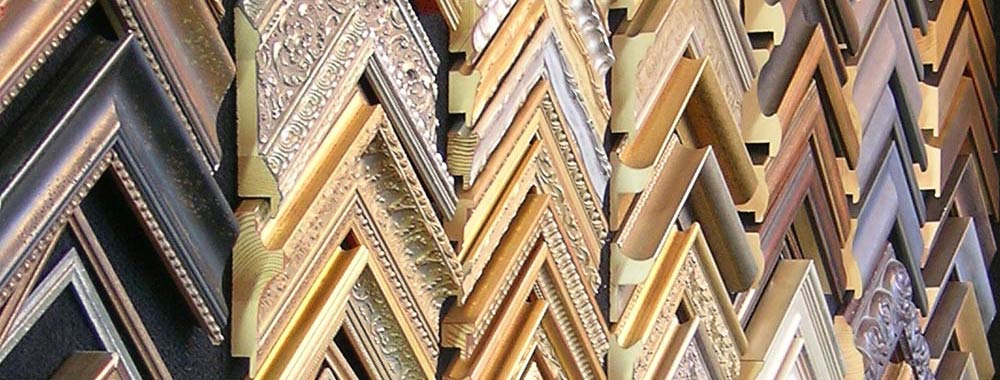| art supplies | framing | gallery |
| art supplies | framing | gallery | |
||
|
| main page | framing | services | project ideas | products | location & hours | |
 |
Hundreds of OptionsOur frame shop is 100% custom. This means that everything we offer is custom-tailored to you and your specific framing project. We have hundreds of wood and metal moulding samples on display for you to choose from, as well as a broad range of matboard and glazing options to meet a variety of preservation needs. There is almost no limit to the number of possible combinations. From postage stamps to largescale paintings on canvas or linen, our framing personnel have the knowledge and expertise to work with you in selecting the options that will properly preserve as well as beautify your prized possessions or works of art. Frame Mouldings:Our frame mouldings are supplied by quality brands like Larson Juhl, Roma Moulding, and Nielsen-Bainbridge. A carefully chosen frame moulding is the backbone of any custom framing package. Our experienced framing staff will help you select the design that will enhance your artwork as well as complement your décor. We will help you find the right profile, colour, style and texture to add the finishing touch to your framed object. Our design area features hundreds of moulding samples that are being constantly updated. The selection ranges from sleek contemporary metals to hand-finished natural woods, and ornately sculpted profiles with classic gold-leaf. Matboard:Matting plays an important role in both preservation and design. It serves as a visual transition between the frame and the artwork. A neutral mat colour will make the artwork the main focus, and will allow you to move the piece from room to room without conflicting with the décor. If a bolder impact is more to your liking, we have hundreds of coloured and textured matboard options to choose from, including metallic, leather, linen, and suede. Since the matting is in constant contact with the artwork, it should not contain any substances that could harm the object. For this reason, we only use conservation or archival quality matboards that are made from 100% alpha-cellulose or 100% cotton fiber. Well-chosen matting and backing boards can help to protect your framed object against degradation and contaminants in the environment. Acid-Free versus Archival Rising Museum BoardRising Museum Board is:100% Cotton *Due to the use of carbon black dyes to manufacture the Black Rising Museum Boards, there will be some minor scuffing.Glazing:Glazing protects the framed object from physical damage and insulates against changes in temperature and humidity. Modern technology has produced a number of exciting advances in glazing choices to help protect the artwork while enhancing your enjoyment of it. Ultraviolet radiation is one of the chief dangers to framed art. It can cause fading of colours and can accelerate oxidation and promote chemical degradation of paper. Regular glass blocks approximately 45% of UV radiation, which is tolerable for certain kinds of work under certain lighting conditions. For works that will be placed in bright locations or for mediums that are particularly prone to light damage, however, Conservation Glass is available, which blocks almost all of the UV radiation to better protect your work of art. Conservation glass is like sunblock for your artwork, cutting the radiation reaching the artwork by at least 97%. Sometimes light reflected off the surface of the glass is a more pressing concern than the light reaching what's inside the frame. For these applications we have two options. Reflection Control Glass diffuses light reflected from its surface, though it has a slightly hazy appearance that somewhat obscures the work inside. Our Anti-Reflection Glass, on the other hand, is a great option that makes reflections nearly invisible while also maintaining extreme crystal clarity. Both options offer a moderate increase in UV protection as well. For the absolute best protection and presentation of your valuable treasures, Museum Glass is the ultimate option, combining the UV filtering property of conservation glass with an anti-reflective coating that eliminates annoying glare from windows and other light sources. Plexi-glass is also available, most often recommended for large-scale glazing applications because it is much lighter than conventional glass. UV filtered plexi-glass is an option when it is necessary to balance light control with weight considerations. Plexi-glass is also much less brittle and significantly more shatter resistant, though it is more prone to scratching. As always, we are happy to assess the needs of your particular situation to find the glazing option that is best for you. For more information, or to schedule an appointment, please call: 306-664-3385, e-mail or stop in. For more information on conservation standards, please consult the Canadian Conservation Institute website: |
| The GALLERY / art placement inc. 228 - 3rd avenue south, saskatoon, SK, canada, S7K 1L9 |
  |
|
p: 306.664.3385 f: 306.933.2521 |
© all images, text, and site design |